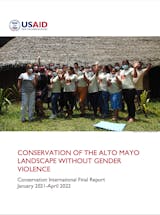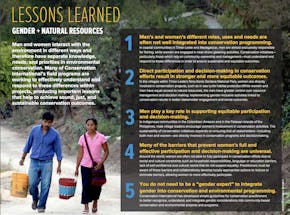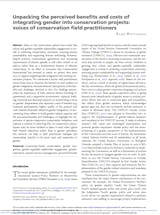Gender equality
Gender and social norms are diverse and dynamic — and they influence people’s relationship with the environment.
Around the world, men and women use nature differently and are therefore affected in different ways when it is degraded or more effectively managed. Yet, too often, these differences are not understood or recognized.
Conservation International is committed to advancing gender equality and ensuring that women’s perspectives and priorities are embedded into our work to achieve lasting impacts. For more than a decade, our projects have intentionally supported women's access to resources and participation in decisions about the nature they rely on.
Guided by our human rights-based approach, Conservation International aims to ensure that all people, regardless of their gender, can fully engage in and benefit from our conservation initiatives.
For more than a decade, our projects have intentionally promoted women's access to resources and their participation in decisions about the nature they, and their communities, rely on.
Timeline
2013: Conservation International adopts a human rights-based approach to conservation, including a commitment to gender equality.
2014: We develop one of the first tools for integrating gender into conservation projects and pilot its use in more than 20 sites over the next decade as a means to build field staff capacity.
2014: The Indigenous Women’s Fellowship is launched. It is designed to engage and elevate emerging leaders in conservation, eventually reaching close to 75 women worldwide.
2021: Conservation International develops guidance for staff on how to plan for, and respond to, gender-based violence in conservation programming. Conservation International-Peru implements a project focused on ending gender-based violence in an Indigenous community.
2023: Conservation International boosts accountability for gender integration via our Safeguard System, which requires fit-for-purpose gender analyses, plans and indicators for all new projects.
2024: Conservation International reaffirms its commitment to gender equality in a new institutional policy.
How do we do it?
We co-design conservation activities to be useful and accessible to women and men, ensuring that project benefits target their priorities and are equitably distributed.
Our projects help women benefit from, and make decisions about, material, financial, human, social or political resources.
We partner with women and their organizations to support their leadership and effective conservation decision-making.
It’s about genuinely wanting to consider what women have to say, giving women the right to express their voices; show themselves to be the experts who can take the decisions.
Hindou Oumarou Ibrahim, Conservation International Board Member and President of the Association for Indigenous Women and Peoples of Chad (AFPAT)
Our role
We partner with communities, women leaders and women’s organizations to support women’s leadership in conservation decision-making at all levels. For example, our projects include thoughtful and culturally appropriate ways to engage women, such as by providing childcare during events, including a female facilitator and conducting separate or additional meetings with women. We also promote women’s conservation leadership – for example through fellowships, peer mentoring or partnerships with local women’s groups.
The right tools and approaches vary — they rely on a solid understanding of the social and gender dynamics in which the project operates. To this end, project-specific gender analyses and workplans are becoming more common across Conservation International’s portfolio. We are also hiring staff with gender integration experience and building the capacity of existing staff.
Conservation International also recognizes that advancing gender equality requires engaging with men to address the cultural and normative barriers that impede gender equality. For example, in Peru we worked in an Awajún Indigenous community to provide training on women’s legal rights and the prevention of sexual violence — and helped develop support systems for survivors of gender-based violence. The project engaged men from the community on how to achieve justice for survivors, among other issues.
Conservation International recognizes gender-expansive identities of people who do not identify with traditional gender roles and works to promote safe spaces for everyone to express their gender identity and be their authentic selves.
Select case studies

Global
This study demonstrates how gender considerations can be meaningfully integrated into a multi-tiered conservation fund and lead to significant gender-related impacts.
Gender mainstreaming in the Critical Ecosystem Partnership Fund

Timor-Leste
This study provides lessons learned and recommendations for delivering gender outcomes in community-based conservation contexts.

Madagascar
This study shows how a climate smart agriculture project has influenced women's empowerment and identifies strategies for designing gender inclusive agriculture interventions.

Cambodia
This study demonstrates CI’s holistic approach to women’s economic empowerment and community fisheries and provides recommendations for gender integration in community-based conservation enterprises.

Philippines
This study highlights the importance of gender-inclusive protected area design and management, and provides recommendations for how to gather and analyze this information.
Resources
From our blog
Related content
- WATCH: Women Leading Conservation - Kenya
- WATCH: Empowering Maasai Women for Climate Action
- WATCH: Women on a Mission, Technology Meets Tradition
- WATCH: Women on a Mission, Poachers to Peacekeepers
- WATCH: Perempuan - Indigenous Women in the Fam Islands
- WATCH: Indigenous Women of the Amazon
- READ: Safeguards Overview
- READ: Diversity, Equity and Inclusion
- READ: Accountability and Grievance Mechanism
- READ: Amazon Indigenous Women’s Fellowship program
- READ: Conservation and Peace
- READ: Men and Women as Conservation Partners in Conflict Settings
Publications
Our priorities
Principles that guide our work:
Diversity, equity and inclusion
Respecting human rights
Gender equality
Science-based restoration



